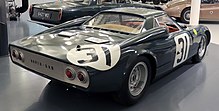Rover-BRM
A series of potential road cars were also produced, starting with the early prototype Jet 1, through the more developed examples T2 and T3, followed by the T4, which performed demonstration laps around the Le Mans circuit before the 1962 race.
A prize was to be awarded for the first gas turbine car to complete 3,600 km over the 24 hours, an average speed of 150 km/h, approximately 93 mph.
[1] The first test runs were at the MIRA track in April 1963, driven by Graham Hill who described it thus, "You’re sitting in this thing that you might call a motor car and the next minute it sounds as if you’ve got a 707 just behind you, about to suck you up and devour you like an enormous monster.
For the 1964 season, the major change was the addition of a pair of ceramic rotary regenerators to the gas turbine, so as to improve efficiency.
Allegedly owing to sand from the side of the course being sucked in when Graham Hill ran wide early on, the turbine blades were damaged.
The engine began to overheat and for the rest of the race had to be monitored carefully to ensure that the exhaust gas temperature wasn't exceeded.
Some hours later, while Stewart was driving, the tip of a turbine blade broke off and damaged one of the regenerators with a massive explosion, although the engine kept on running.
[4] After the 1965 Le Mans, the car was once briefly tested on public roads by the magazine Motor, but retired completely by 1974.

